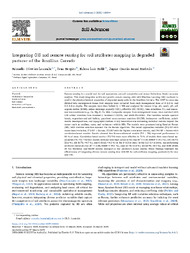Integrating GIS and remote sensing for soil attributes mapping in degraded pastures of the Brazilian Cerrado.
Integrating GIS and remote sensing for soil attributes mapping in degraded pastures of the Brazilian Cerrado.
Autoria: LOUZADA, R. O.; BERGIER, I.; BOLFE, E. L.; BARBEDO, J. G. A.
Resumo: Abstract: Remote sensing is a crucial tool for soil assessment, yet soil complexity and sensor limitations hinder accurate analysis. This study integrates active and passive remote sensing data with Machine Learning (ML) methods to predict the physicochemical properties of degraded sandy soils in the Brazilian Cerrado. The 1197?ha area was divided into management zones. Soil samples were collected from each management zone at 0–0.2?m and 0.2–0.4?m depths. The samples were then bulked (n?=?99) and analyzed for texture (clay, silt, sand), pH, soil organic matter (SOM), cation exchange capacity (CEC), effective CEC (ECEC), base saturation (V), and macro- and micronutrients (e.g., Ca, Mg, K, Fe, Mn). Composite samples from management zones, were matched with 128 orbital variables from Sentinel-1, Sentinel-2 (2023), and ALOS-PALSAR-1. The variables include spectral bands, vegetation and soil indices, gray-level co-occurrence matrices (GLCM), backscatter coefficients, polarimetric decompositions, and topographic indices. A key innovation was evaluating statistical metrics beyond the mean—such as medians, sums, and variances—within MZs. The models were processed using Random Forest (RF), with variable selection assessed via the Boruta algorithm. The tested approaches included (T1) RF with mean-based variables, (T2) RF +?Boruta, (T3) RF with the highest correlation metrics, and (T4) RF +?Boruta with correlation-based metrics. Results showed that Boruta-enhanced models (T2?+?T4) improved performance in 89?% of cases. Correlation-based metrics (T3/T4) were more effective in 72?% of models than mean-based approaches (T1/T2). The best models demonstrated high accuracy for clay (R² = 0.81; RMSE = 25.2?%), CEC (0.73; 23.6?%), silt (0.71; 44.7?%), and K (0.62; 44.3?%) in the 0–0.2?m layer. In the 0.2–0.4?m layer, top-performing attributes included clay (R² = 0.86; RMSE = 19.1?%), sand (0.78; 10.6?%), silt (0.76; 39.3?%), and SOM (0.68; 21?%). Elevation and GLCM metrics emerged as key predictors across depths. These findings highlight the effectiveness of integrating diverse remote sensing data with ML for soil attributes mapping, particularly for clay and CEC.
Ano de publicação: 2025
Tipo de publicação: Artigo de periódico
Unidade: Embrapa Agricultura Digital
Observações
1 - Por padrão são exibidas publicações dos últimos 20 anos. Para encontrar publicações mais antigas, configure o filtro ano de publicação, colocando o ano a partir do qual você deseja encontrar publicações. O filtro está na coluna da esquerda na busca acima.
2 - Para ler algumas publicações da Embrapa (apenas as que estão em formato ePub), é necessário ter, no celular ou computador, um desses softwares gratuitos. Sistemas Android: Google Play Livros; IOS: iBooks; Windows e Linux: software Calibre.
Acesse outras publicações
Acesse a Base de Dados da Pesquisa Agropecuária (BDPA) para consultar o acervo completo das bibliotecas da Embrapa.

